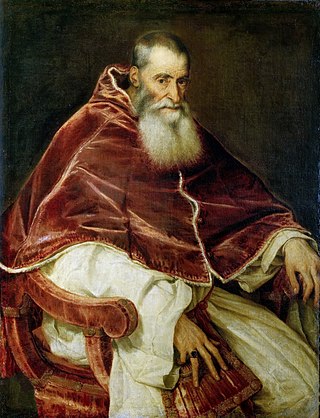
Museo di Capodimonte is an art museum located in the Palace of Capodimonte, a grand Bourbon palazzo in Naples, Italy designed by Giovanni Antonio Medrano. The museum is the prime repository of Neapolitan painting and decorative art, with several important works from other Italian schools of painting, and some important ancient Roman sculptures. It is one of the largest museums in Italy. The museum was inaugurated in 1957.

Pope Paul III and His Grandsons is an oil on canvas painting by Titian, housed in the Museo di Capodimonte, Naples. It was commissioned by the Farnese family and painted during Titian's visit to Rome between autumn 1545 and June 1546. It depicts the scabrous relationship between Pope Paul III and his grandsons, Ottavio and Alessandro Farnese. Ottavio is shown in the act of kneeling, to his left; Alessandro, wearing a cardinal's dress, stands behind him to his right. The painting explores the effects of ageing and the manoeuvring behind succession; Paul was at the time in his late seventies and ruling in an uncertain political climate as Charles V, Holy Roman Emperor came into ascendancy.

Portrait of Lavinia Vecellio is an oil on wood portrait by Titian, from c. 1545. It is believed to depict his daughter Lavinia. It is held in the Museo di Capodimonte, in Naples.

Portrait of Pope Paul III is anoil on canvas portrait by Titian of Pope Paul III, produced during the pope's visit to Northern Italy, in 1543. It is in the collection of the Museo di Capodimonte, in Naples.

Salvatore Fergola, was an Italian painter, mainly of landscapes or vedute in and around his native Naples. He is considered a member of the School of Posillipo.

Danaë is a circa 1623 oil on canvas painting by the Italian artist Orazio Gentileschi. It is an example of an Italian Baroque painting and is now in the collection of the J. Paul Getty Museum, in Los Angeles.

Sacrificial Scene is a grisaille tempera on canvas painting by Pontormo, produced around 1520 and now in the National Museum of Capodimonte in Naples. It was probably originally produced as part of the decoration of an interior in honour of Cosimo de' Medici.

Last Judgement is a 1549 tempera on panel painting by Marcello Venusti after Michelangelo's Sistine Chapel The Last Judgement (1541). It is now in the National Museum of Capodimonte in Naples.

Portrait of Philip II is an oil on canvas portrait by Titian of Philip II of Spain wearing the chain of the Order of the Golden Fleece. It is in the collection of the Museo di Capodimonte, in Naples.

Minerva between Geometry and Arithmetic is a fresco fragment, usually attributed to Paolo Veronese, from 1550, but by some art historians to Anselmo Canera or Giambattista Zelotti. It was painted for the Palazzo de Soranzi in Castelfranco Veneto but is now in the Palazzo Balbi, in Venice.

The Child Bitten by A Lobster is a drawing by the Italian painter Sofonisba Anguissola, executed in chalk and pencil on light blue paper, and dated to around 1554. It is in the collection of the Museo di Capodimonte, in Naples.

Madonna and Child with Saint Catherine of Alexandria is a c.1550 oil on panel painting by the studio of Titian, now in the Galleria degli Uffizi. It was restored around the end of the 18th century, when the present carved and gilded frame was probably added.

Madonna and Child with Donors or Sacred Conversation with Donors is a c. 1525 oil on panel painting by Palma Vecchio, now in the Museo nazionale di Capodimonte in Naples.

Portrait of Cardinal Alessandro Farnese is a c. 1545–46 oil on canvas three-quarter-length portrait of Alessandro Farnese the Younger (1520–1589) by Titian. It is held in the Museo di Capodimonte, in Naples.

Portrait of Ranuccio Farnese is an oil on canvas painting of Ranuccio Farnese by Titian, from c. 1542. It is held in the National Gallery of Art, in Washington, D.C.. One of the first portraits of a Farnese by the artist, it is signed "Titianvs F.".

Portrait of Pope Paul III with Camauro is an oil on canvas painting by Titian, from c. 1545-1546. It is held in the Museo nazionale di Capodimonte, in Naples.

Portrait of Charles V or Portrait of a Man Wearing the Order of the Golden Fleece is an oil on canvas painting by Titian, from c. 1549. It is held now in the Museo di Capodimonte, in Naples.

Saint Jerome or Penitent Saint Jerome is an oil-on-canvas painting executed c.1640–1650 by the Italian artist Guercino, now in the Royal Palace of Naples.

Saint Joseph's Dream is an oil-on-canvas painting executed ca. 1615–1650 by the Italian Baroque artist Guercino, now in the Royal Palace of Naples.

Apollo and Marsyas is a 1637 oil on canvas painting by Jusepe de Ribera, now in the Museo nazionale di Capodimonte in Naples. Heavily influenced by Caravaggio, he produced another version, also in 1637, now in the Royal Museums of Fine Arts of Belgium in Brussels.




















